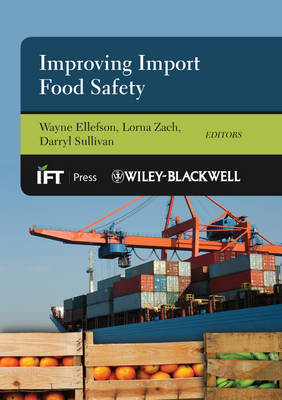
Improving Import Food Safety
Wiley-Blackwell (Verlag)
978-0-8138-0877-2 (ISBN)
Food safety has been a global concern for many years. While global sourcing of foods and ingredients provides great opportunity for variety and diversity of cultural products, there are significant risks. Programs that regulate food safety and quality in countries around the world vary in their scope and effectiveness, with many being underfunded. Rapidly developing countries may lack the expertise, laboratory resources for testing, and established inspection programs to adequately promote the safety of foods. Rather, these countries may be more focused on providing enough food for their citizens. Lack of documentation or traceability in the exporting country can further exacerbate the situation. Of course, safety problems in food imported from more developed countries also occur, and the source of food borne disease outbreaks are found regularly within the United States.
Improving Import Food Safety gathers together vital information on the food safety programs of national governments, the food industry, and the testing industry. Chapters have been contributed by authors from the United States, Latin America, Europe, and Asia. Readers will learn about a variety of regulatory approaches to food safety at the federal and state levels in the United States, as well as in selected countries and within the food industry itself. They will also gain insights into the nature and source of safety problems, in addition to approaches to food safety around the world.
The book is divided into three sections:
Highlighting Key Issues: authors illustrate the millions of permutations for the origin of ingredients, discussing the difficulty if policing imports, providing a unique perspective on the economic situation in China and insight into development of support for small farm producers in Mexico.
Legal and Regulatory Issues/Structures in the USA and Abroad: describes the legal and regulatory system in the European Union, the United States, and China, plus a chapter addressing global approaches to fraud.
Potential Strategies to Improve Import Safety: presents strategies to deal with what are ultimately global issues, but on multiple levels. Perspectives are provided by authors from Industry, and industry trade association, academia, and a recently semi-retired, global ambassador or food safety.
Readers will find this book noteworthy because of the diverse topics and perspectives offered on the challenges of keeping food safe in a global economy. Authors come from a variety of backgrounds, and each has provided a unique perspective on this critical topic. The volume is aimed at importers and exporters of food and ingredients; food microbiologists, food safety and QC/QA personnel; regulatory and legal personnel in food manufacturing companies; food policy makers and regulatory officials and facility and graduate students in food science.
The Editors Wayne Ellefson, Covance Laboratories, Inc., Madison, Wisconsin, USA. Lorna Zach, Center for Human Performance and Risk Analysis, Department of Industrial and Systems Engineering, University of Wisconsin-Madison, Madison, Wisconsin, USA and System Solutions for the Food Industry, Mt. Horeb, Wisconsin, USA. Darryl Sullivan, Covance Laboratories, Inc., Madison, Wisconsin, USA.
Contributors xiii Preface xvii
Acknowledgment xix
Part I Highlighting Key Issues 1
Chapter 1 Emerging Global Food System Risks and Potential Solutions 3
Shaun Kennedy
Overview 3
Supply Chain Complexity 4
Increasing Role of Imports 6
Unusual Sources for Imports 7
Other Emerging Food Safety Risks 10
Economically Motivated Adulteration 11
Other Emerging Intentional Threats 13
Potential Solutions 15
Conclusions 19
References 19
Chapter 2 A Cooperative Federal–State Approach for Monitoring Imported Foods: Reviewing the New York State Model 21
Joe Corby
Introduction 21
State and Local Government Strengths 23
The New York Model for a Cooperative Federal–State Approach for Monitoring the Safety of Imported Food 25
Examples of Violative Imported Food Products Found in the Pilot Cooperative Project 35
Discussion 41
Conclusions 42
References 42
Chapter 3 The Impact of the Chinese Development Model on Food Safety 45
Wenran Jiang
Introduction 45
China’s Explosive Economic Growth and its Impact 46
China as a Growing Food Superpower 51
China’s Food Safety Regimes 53
China’s Food Safety Challenges 57
Conclusions 61
Notes 62
References 63
Chapter 4 The Role of Public–Private Partnerships on the Access of Smallholder Producers of Mexican Cantaloupe to Fresh Produce Export Markets 65
Belem Avendano, Clare Narrod, and Marites Tiongco
Foodborne Outbreaks and the Increasing Demand for Food Safety in Fruit and Vegetables 66
Production Trends of the Cantaloupe Industry in Mexico 71
Responses to Food Safety Problems Associated with Cantaloupe Outbreaks 74
Major Barriers to Market Access for Small Mexican Producers in the Cantaloupe Supply Chain 76
The Role of Private–Public Partnerships in Facilitating Smallholders to Overcome Barriers to Export Market Entry 78
Summary and Conclusions 81
Notes 82
References 83
Part II Legal and Regulatory Issues/Structures in the United States and Abroad 87
Chapter 5 Improving US Regulation of Imported Foods 89
Neal Fortin
Introduction 89
The Major Federal Agencies 91
The FDA Import Process 92
Prior Notice of Import 93
USDA’s Import System 98
Other Import Controls 100
Country-of-origin Labeling 103
Challenges Facing Import Regulation 104
International Standards – Codex 106
Conclusions 106
References 108
Chapter 6 EU Food Safety Regulation and Trust-enhancing Principles 111
Ellen Vos
Introduction 111
Food Regulation: Between Market and Safety 112
The EU’s Failings in Ensuring Food Safety 114
The EU’s New Regime on Food Safety Regulation 115
Restoring Trust in EU Decision-making on Foods 118
Concluding Remarks 125
Acknowledgment 126
Notes 126
References 129
Chapter 7 Experience of Food Safety Authorities in Europe and the Rapid Alert System 133
Roger Wood
Introduction 133
The EU Approach to Legislation in the Food Sector 134
Food Crises 135
Risk Assessment and Risk Management and the EFSA 136
The Rapid Alert System for Food and Feed 141
Notes 148
Chapter 8 The Development of and Challenges Facing Food Safety Law in the People’s Republic of China 151
Yuanyuan Shen
Introduction 151
From “Food Hygiene” to “Food Safety”: A Brief History of the Development of China’s Food Safeguard System (1978–2009) 153
China’s Food Safeguard System Today 165
The Challenges China Faces in Food Safeguard Improvement 181
Conclusions 186
Acknowledgments 187
Notes 187
References 192
Chapter 9 Defining Food Fraud and the Chemistry of the Crime 195
John Spink
Introduction 195
Food Fraud 196
Diversion, Parallel Trade, and Gray Market 203
Criminology and the Chemistry of the Crime 204
Improving Import Food Safety 208
Conclusions 213
References 214
Part III Potential Strategies to Improve Import Safety 217
Chapter 10 Tracking and Managing the Next Crisis 219
Henry Chin, Nancy Rachman, and Maia Jack
Introduction 219
Tracking the Next Crisis 220
Issue Management Tools 227
Conclusion 233
Notes 234
Chapter 11 Food Product Tracing 235
Jennifer McEntire
Introduction 235
Current US Recordkeeping Requirements 236
Global Recordkeeping Guidance and Practices 237
Commercial Product Tracing Standards 238
Food Industry Factors Affecting Traceability 241
Recommendations for Product Tracing 244
Commingling – A Special Case for
Product Tracing 246
Traceability Versus Recall Ability 247
Product Tracing as a Food Safety Tool for Imports 247
References 248
Chapter 12 Improving the Safety of Imported Foods with Intelligent Systems: The Case of United States–Mexico Fresh Produce Supply Chain 251
William Nganje, Na Hu, Timothy Richards and Albert Kagan
Introduction 252
Assessment of Threat and Vulnerability 259
Data and Procedure 261
Optimal Control Procedure 263
Results and Discussion 265
Notes 269
Appendix 270
References 272
Chapter 13 Testing with Confidence in the Pursuit of Global Food Safety 275
Ronald L. Johnson and Robert E. Koeritzer
Introduction 275
AOAC® International: Official Methods of Analysis sm 279
Evolution of Method Development and Validation 280
AOAC Research Institute 280
Initial Step in AOAC Harmonization of Rapid Microbiological Test Kits 284
The AOAC Guidelines Under Revision 289
References 291
Chapter 14 Global Food Protection: A New Organization is Needed 293
William H. Sperber
Introduction 293
Background 294
Proposal 298
Conclusion 301
Note 302
References 302
Chapter 15 Summary and Recommendations for the Safety of Imported Foods 303
Lorna Zach, M. Ellin Doyle, Vicki Bierand Chuck Czuprynski
Introduction 305
Summary of Current Concerns 306
Recommendations to Improve the Safety of Imported Foods 316
Concluding Recommendations 321
Conclusion 328
Acknowledgments 328
Notes 329
References 329
Index 335
| Erscheint lt. Verlag | 9.1.2013 |
|---|---|
| Reihe/Serie | Institute of Food Technologists Series |
| Verlagsort | Hoboken |
| Sprache | englisch |
| Maße | 158 x 236 mm |
| Gewicht | 667 g |
| Themenwelt | Naturwissenschaften |
| Technik | |
| ISBN-10 | 0-8138-0877-4 / 0813808774 |
| ISBN-13 | 978-0-8138-0877-2 / 9780813808772 |
| Zustand | Neuware |
| Haben Sie eine Frage zum Produkt? |
aus dem Bereich


